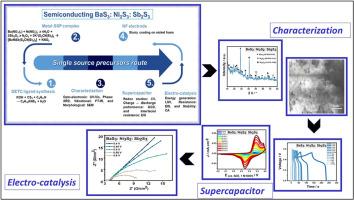提高能量储存和生产效率:利用 BaS3:Ni2S3:利用二硫代氨基甲酸盐前体合成的 Sb2S3 实现增强型可持续能源解决方案
IF 4.3
3区 材料科学
Q2 CHEMISTRY, MULTIDISCIPLINARY
引用次数: 0
摘要
在能源使用日益增长的时期,科学界和能源利益相关者一直在密切关注电化学储能。为了增强电荷存储设备的功能,在生产新型 BaS3 时采用了二乙基二硫代氨基甲酸配体作为螯合剂:Ni2S3:Sb2S3。半导体 BaS3:Ni2S3:Sb2S3 的能带隙为 2.97 eV,光吸收率高,因而具有良好的光活性。所制备的钙化物的平均结晶尺寸为 19.69 nm,并显示出出色的结晶度和混合结晶相。此外,还利用红外光谱研究了金属硫化物的连接情况,结果表明它们在 500 至 875 cm-1 之间变化。由于其形态特征,这种钙化物具有不同的电化学反应位点。BaS3.Ni2S3::::的电化学性能:Ni2S3:Sb2S3 的电化学性能进行了评估。BaS3: Ni2S3: Sb2S3 的比电容高达 1019.4 F g-1,功率密度为 11931.26 W kg-1:Ni2S3:Sb2S3 已被证明是一种出色的储能电极材料。0.57 Ω的可比串联电阻(Rs)进一步巩固了其卓越的电化学性能。在电催化过程中,该电极产生了塔菲尔斜率为 348 mV 和 119 mV dec-1 的 OER 过电位。相比之下,HER 活性的过电位和塔菲尔斜率分别为 211 mV 和 100 mV/dec。本文章由计算机程序翻译,如有差异,请以英文原文为准。

Amplifying energy storage and production efficiency: Utilizing BaS3: Ni2S3: Sb2S3 synthesized from dithiocarbamate precursors for enhanced and sustainable energy solutions
During this period of increasing energy use, the scientific community and energy stakeholders have been closely monitoring electrochemical energy storage. In an attempt to enhance the functionality of charge storage devices, diethyldithiocarbamate ligand is employed as a chelating agent during the production of the novel BaS3: Ni2S3: Sb2S3. The semiconductor BaS3: Ni2S3: Sb2S3, which was made in an environmentally friendly manner, showed good photoactivity due to its 2.97 eV energy band gap and light absorption. The resultant chalcogenide had an average crystallite size of 19.69 nm and displayed outstanding crystallinity with mixed crystallographic phases. Furthermore, infrared spectroscopy was used to investigate metallic sulfide connections, and the findings indicated that they varied between 500 and 875 cm−1. This chalcogenide featured varied sites for electrochemical reactions due to its morphology. The electrochemical performance of BaS3: Ni2S3: Sb2S3 was assessed using a conventional three-electrode setup. With a specific capacitance of up to 1019.4 F g−1 and a power density of 11931.26 W kg−1, BaS3: Ni2S3: Sb2S3 has proven to be an excellent electrode material for energy storage. This remarkable electrochemical performance was further reinforced by the comparable series resistance (Rs) of 0.57 Ω. During electrocatalysis, the electrode produced an OER overpotential with a Tafel slope of 348 mV and 119 mV dec−1. In contrast, the overpotential and Tafel slope in terms of the HER activity and were 211 mV and 100 mV/dec, respectively.
求助全文
通过发布文献求助,成功后即可免费获取论文全文。
去求助
来源期刊
CiteScore
7.80
自引率
2.50%
发文量
605
审稿时长
40 days
期刊介绍:
The Journal of Physics and Chemistry of Solids is a well-established international medium for publication of archival research in condensed matter and materials sciences. Areas of interest broadly include experimental and theoretical research on electronic, magnetic, spectroscopic and structural properties as well as the statistical mechanics and thermodynamics of materials. The focus is on gaining physical and chemical insight into the properties and potential applications of condensed matter systems.
Within the broad scope of the journal, beyond regular contributions, the editors have identified submissions in the following areas of physics and chemistry of solids to be of special current interest to the journal:
Low-dimensional systems
Exotic states of quantum electron matter including topological phases
Energy conversion and storage
Interfaces, nanoparticles and catalysts.

 求助内容:
求助内容: 应助结果提醒方式:
应助结果提醒方式:


